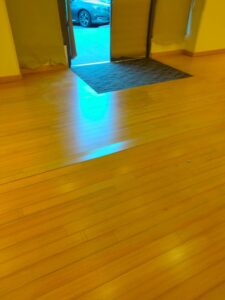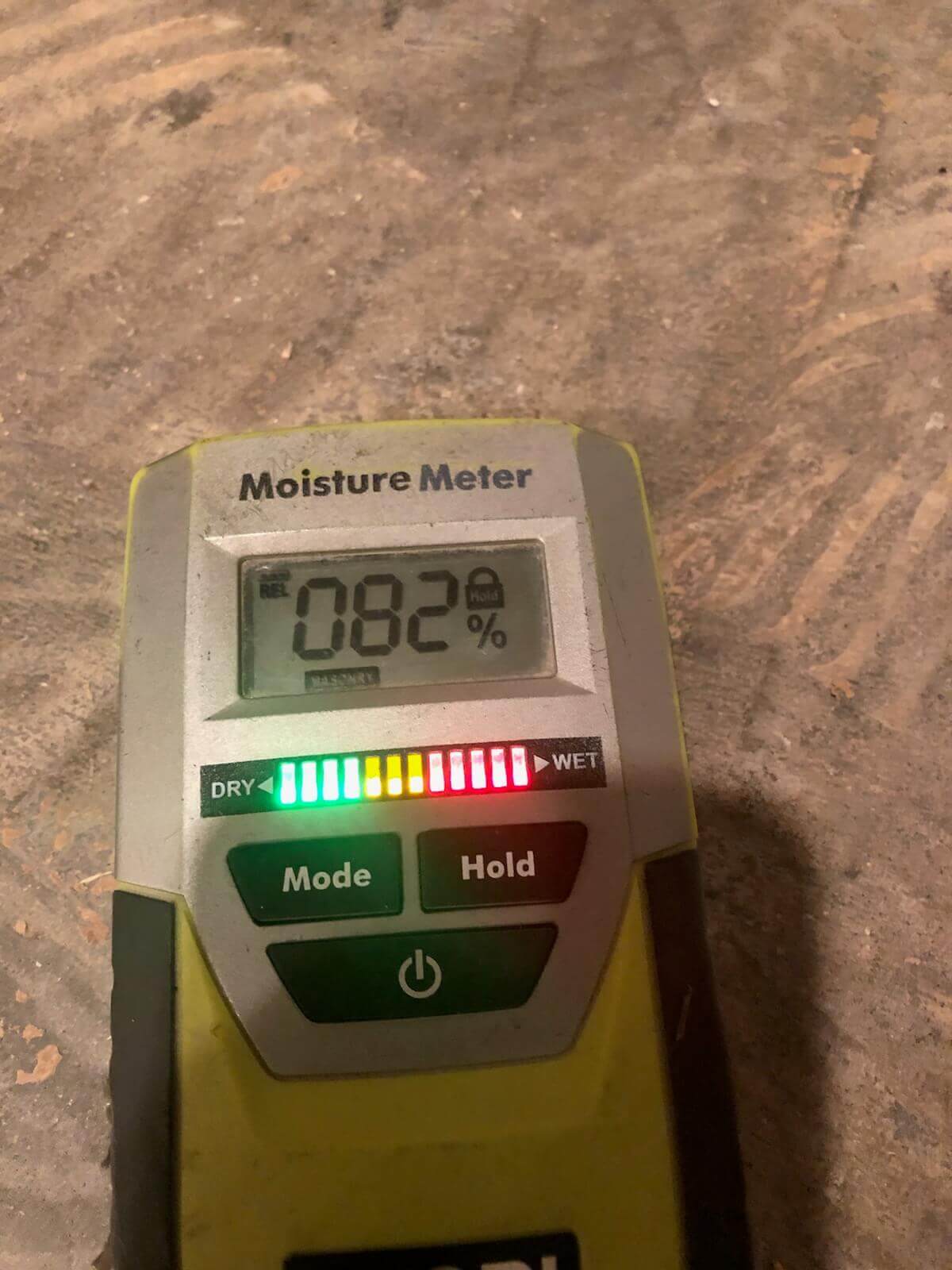May 14, 2021
The pros and cons of bamboo flooring are something that every prospective buyer should know before deciding if it's for them. Otherwise, this can happen --->
Don't be alarmed at the picture you see. This is to show you what will happen if things are not done correctly with this floor.
This buckling was one of several spots throughout the entire floor. It did not occur because of a flood or a burst pipe. This happened because the previous installers did not take the necessary precautions when installing this bamboo floor.
Precautions that I will highlight for you in this article to hopefully stop you from making the same mistake!
I'll then provide you with some helpful tips on what to do and not do when installing your floor.

My intention is not to scare you away from this product as I think it's one of the most beautiful and sustainable floors you can buy.
I'm merely pointing out some very crucial steps you must take to ensure you're happy with the result. So put these on your checklist, and you will not have a problem.
Bamboo flooring is stunning and exotic. It's been a choice for many people for a long time. A common question folks ask is the difference between vertical and horizontal bamboo. The difference is in the construction of the floor. Horizontal bamboo has a signature etched look about it, with random markings throughout each plank. Vertical bamboo has straight up and down striations. They come in both carbonized and natural finishes, suitable for different areas and applications. You can also get bamboo in many other stains, including red, blue, gray, brown, and I've even seen black.
Technically it's not a wood, but actually, grass and folks have been attracted to its beauty whether it's carbonized, horizontal, strand woven, hand-scraped - whatever the style, it certainly is beautiful to look at. It is environmentally friendly, so anyone with a green agenda naturally gravitates towards it.
Since this product generally glues down to your subfloor, it's very quiet to walk on. Contrary to other types of flooring like laminate or even click vinyl plank that floats, you will not get a hollow sound unless you don't pre the subfloor correctly.
Even though it's not technically a hardwood, realtors and buyers alike love the exotic look and feel of bamboo flooring. It adds instant value to your home instead of carpet or laminate flooring.
Moisture mitigation is the most critical factor to consider when buying bamboo flooring. I'm going to expand on this below, but please note, bamboo flooring is affected by moisture more than any other floor I know. The formula is straightforward: it will not be a problem if you install it correctly, but it will be if it's not. Strand woven bamboo is the flagship of the product line, in my opinion, because it's incredibly dense and hard to the point that it is much harder than a lot of conventional hardwood flooring.
The differences in manufacturing processes make non-strand woven bamboo much softer than its counterpart; hence, they can get banged up pretty easily. This doesn't mean you shouldn't install it on this factor alone. It means to select the type of bamboo depending on the use and lifestyle of the area. So if it's a small boutique store aimed at the older segment; or an apartment with just you in it, then it'll be fine. It will not be suitable for a very active household with many pets, kids, and guests.
Since bamboo flooring manufacturers almost always recommend a special adhesive and sealer, it's a little bit more labor-intensive than conventional hardwood flooring, so you pay more.
If you're not in a hurry, this won't be too inconvenient, but I strongly recommend you acclimate solid bamboo for two weeks before installation. For engineered bamboo flooring, acclimate according to the manufacturer's instructions - but add an extra day. I will explore this portion in more detail below.
Here is another angle of that bamboo floor that went horribly wrong.
It buckled so severely that it was a trip hazard, and when you walked over it, the boards had wholly separated from the concrete subfloor so you could bounce on it. Here are five quick tips to help you avoid this situation:
1. Moisture Testing
First and foremost is before even considering laying your floor down, you should take a moisture meter and test the concrete floor. Please do not confuse a cheap handheld moisture meter you can get from Lowe's or Home Depot, which measures other materials like sheetrock and wood.
Make sure it can measure concrete moisture content.
These meters are very different and considerably more expensive, but the cost savings of replacing an entire floor due to not doing this are significant.

If you or your installer don't have one, get a professional-grade one here.
I use the Ligno Scanner SDM and Tramex. Both are excellent devices that will give you accurate readings:
The Ligno Scanner SDM measures many different materials based on your input.
Since I do a lot of hardwood flooring, it was vital for me to get a two-in-one device that can give readings of both the subfloor and the material rather than juggle two different devices for different materials.
The Tramex gives both audio and visual signals when it detects excess moisture with a visible light and beeping noise:

2. Acclimation
Depending on the product, I advise clients to acclimate their bamboo for two weeks before installation. This does not mean to store it in the garage!
The material should be inside the house under normal living conditions.
If it's new construction, ensure the installation of all doors and windows is complete and the HVAC running for at least 48 hours before acclimating it. All tape and bedding, texturing, and paint should also be done.
The painting process releases a lot of moisture in the air, so it needs time to dissipate.
Once all of these are done, place the bamboo inside the home. Remember, if it's a solid product, I will not leave it in there for less than two weeks before installation.
3. Sealer
Whether it's strand woven or otherwise, Bamboo is extremely sensitive to subfloor moisture.
Installing it over a wet slab guarantees problems very quickly.
Even if the readings show the slab to be bone dry, I still take all precautions with this floor. That means to seal the slab with a concrete sealer to mitigate any possible moisture down the road.
I have been to dozens of bamboo jobs where the installer didn't do this, and the floors buckled each time.
Seal the slab with the manufacturer's recommended product, or in the case, they don't specify one, you can't go wrong with either Titebond or BoneDry.
4. Adhesive
This isn't negotiable.
Using the manufacturer's recommended adhesive protects you on many levels.
These are urethane-based adhesives, and most of them come with moisture retarding properties.
Just be sure to use the correct trowel if you're using it as a moisture barrier. Check the product's instructions since each differs but generally, you use a smaller trowel when using it as a two-in-one.
You use more product, but you get two layers of protection. I have yet to see a bamboo floor fail when the installers implemented both of these measures.
Even though these measures may sound tedious, trust me when I tell you it's going to save you a lot of headaches down the road.
Many installers are not familiar with how bamboo reacts and don't know the correct methods. So following this checklist means you have recourse should anything go wrong.
If a manufacturer sees that you did all the right things and their product fails, then they will be compelled to compensate you.
However, if you do not adhere to the installation standards or manufacturer's guidelines, they will wash their hands very quickly of the problem, and you're left with an expensive mistake.
Do the right things by your bamboo floor, get it installed correctly, and you'll enjoy it for many years to come.
You can browse a wide range of bamboo flooring here.
I hope this overview helps!